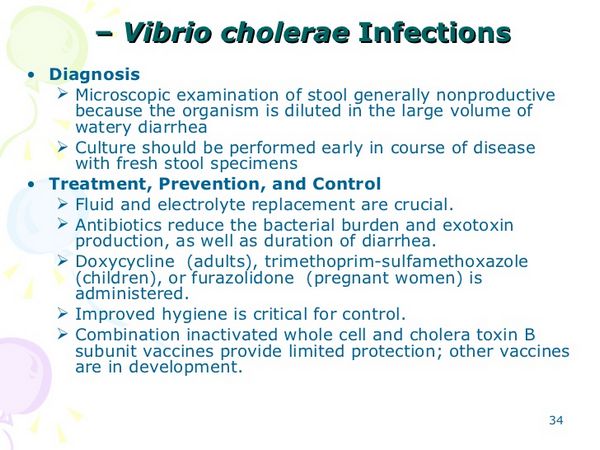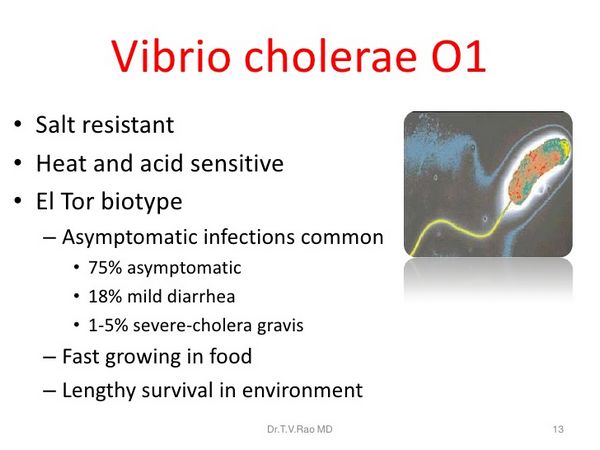Cholera is a fulminant diarrheal disease caused by V cholerae (Box 1). Patients with cholera develop frequent, watery stools, which may reach volumes =1 L/h. If these patients are untreated, they will develop rapid dehydration and electrolyte abnormalities, which may result in death within hours from the onset of disease. Therefore cholera is a medical emergency.

V cholerae is noninvasive and produces diarrhea by the elaboration of a potent enterotoxin. This enterotoxin consists of two subunits that have been well characterized. The circular, pentameric B-subunit binds monosialosyl ganglioside residues on the surface of the intestinal epithelial cell and introduces the enzymatic A-subunit into the cytoplasm. The A-subunit functions as an adenosine diphosphate (ADP) ribosylase and transfers an ADP-ribose moiety from cytoplasmic nicotinamide adenine dinucleotide (NAD) to the cell-membrane-associated adenylate cyclase. ADP-ribosylation renders adenylate cyclase unresponsive to feedback inhibition. The result is dramatically increased intracellular cyclic adenosine monophosphate (cAMP) levels. Elevated cytoplasmic cAMP levels cause massive fluid and electrolyte transit into the bowel lumen, resulting in the characteristic “rice water” stool of cholera.
Clinical Findings
Signs and Symptoms
Patients with cholera initially develop increased peristalsis, a feeling of fullness, and occasionally vomiting. Diarrhea develops rapidly and soon becomes watery. Abdominal pain and high fever are usually minimal or absent and distinctly disproportionate to the amount of diarrhea. Fever, when present, is usually caused by dehydration. Electrolyte abnormalities, from voluminous diarrhea, may manifest as muscle weakness, intestinal ileus, or even cardiac dysrhythmia. The clinical manifestations of infection and the possibility of severe complications correlate with the patient’s hydration and electrolyte abnormalities. Mental status changes secondary to hypoglycemia may also occur. Without urgent fluid and electrolyte replacement therapy, hypovolemic shock and death may occur rapidly.

Laboratory Findings
The stool from patients with cholera tends to lose its fecal odor as the disease progresses and may develop a sweet odor. Also, as the disease progresses and normal fecal material is passed, the stool becomes watery, turbid, and gray. Small flecks of mucus in this gray water give these stools their “rice water” appearance. Blood and neutrophils are generally not present in choleric stools. In the appropriate clinical and epidemiological context (eg, during outbreaks of cholera), a direct examination of stool can be useful for the presumptive identification of V cholerae. A microscopic examination of stool that discloses straight or curved bacilli with rapid, darting, or “shooting star” motility is suggestive of V cholerae. Inhibition of the motility of the organism by V cholerae O1 antiserum further supports the diagnosis of cholera.
Stool from patients with diarrheal disease suspected to be caused by V cholerae should be cultured on a selective and differential media, such as TCBS. Latex agglutination and ELISA-based methods to detect the presence of cholera toxin have been developed. These methods are rapid and may be useful in rapidly detecting patients with cholera in the early phases of disease. Polymerase chain reaction based methods of organism detection have been used successfully to detect V cholerae nucleic acids from choleric stools.
Imaging
Rarely, patients with cholera may develop an ileus as an early manifestation of disease. Abdominal imaging techniques are especially important in such patients since excessive fluid accumulation and visceral rupture may occur.
Differential Diagnosis
Salmonella species, Shigella species, Yersinia enterocolitica, Campylobacter species, and the enteric pathogenic E coli; viruses such as rotavirus and Norwalk agent; and parasites, such as Giardia lamblia and species of Cyclospora and Cryptosporidium are common pathogens that should be considered in the differential diagnosis of diarrheal disease. The diagnosis of these pathogens is achieved by a careful history combined with laboratory testing.
Complications
Profound dehydration and hypoglycemia may result in altered mental status, unconsciousness, seizures, and renal failure. Electrolyte abnormalities may manifest as muscle weakness, intestinal ileus, or sudden death caused by cardiac arrhythmia. Vomiting exacerbates the dehydration, makes oral rehydration difficult, and may lead to aspiration pneumonia. During pregnancy the fluid and electrolyte imbalances may result in fetal death.
Rarely, patients with cholera may develop an intestinal ileus. These patients may accumulate large amounts of fluid in the lumen of the intestine. When this occurs at the onset of disease, the patient may be suspected to have an acute abdomen and cholera may not be suspected. If an ileus develops later in the course of disease and stool volume is used as a basis of fluid replacement, these patients may be inadequately rehydrated and viscus rupture could occur.
Treatment
Primary Therapy
Primary therapy of cholera consists of fluid and electrolyte replacement. Published guidelines for fluid and electrolyte replacement in cholera are available. Either a citrate (10 mmol/L)- or bicarbonate (30 mmol/L)-based solution may be used for oral rehydration. These should contain sodium (90 mmol/L), potassium (20 mmol/L), chloride (80 mmol/L), and glucose (111 mmol/L). The glucose is actively transported into enterocytes. This osmotically drives water from the lumen and into the body. In developing countries, the water residua from boiled rice may be used for rehydration. This is an inexpensive and excellent source of oligosaccharides, which like glucose, aid in the osmotic shifting of water from the lumen to the body.
Intravenous fluid replacement therapy is necessary for patients with severe dehydration (=10% of their body weight) and acidosis (pH <7.2). These patients should be rehydrated with 50% normal saline with 44 mmol/L of bicarbonate. Potassium replacement may be given as needed.
If vomiting is not prominent, oral replacement is usually adequate. If mental status changes are present, hypoglycemia should be treated with intravenous glucose infusion (bolus 3-4 mL/kg of a 25% glucose solution, followed by continuous infusion of 10 mg/kg/h).
Antimicrobial Therapy
Treatment with tetracycline will shorten the duration of cholera (Box 2). Pregnant women and children who develop cholera should be treated with ampicillin. If allergies to penicillin exist, trimethoprim-sulfamethoxazole and furazolidone are also effective.
Prognosis
The prognosis for patients infected during cholera epidemics is often poor. This directly parallels the lack of basic medical care, such as fluid and electrolyte replacement, which exists in the situations that foster epidemic cholera. If patients with cholera are given appropriate fluid, electrolyte, and glucose replacements, the prognosis is good. In many instances, the fluid replacement is roughly based on the volume lost. Patients who are not recognized to have an intestinal ileus may fare poorly. These patients may initially be misdiagnosed or if recognized to have cholera may not receive adequate fluid and electrolyte replacement.
Prevention & Control
A clean water supply and effective sanitation are essential for preventing epidemic cholera. The economic means for effective waste disposal and preventive healthcare are not available to the impoverished; therefore cholera persists. In sporadic cases, patient isolation with appropriate waste disposal and hand washing are important means of preventing the spread of disease.
Two vaccines are currently being studied for high-risk individuals to use. These are a B-subunit, killed whole-cell vaccine (BC-WC) and a live, recombinant attenuated, orally administered vaccine (CVD 103-HgR). These vaccines may offer some protection, but they are not an alternative for clean water. In refugee-type settings, in conjunction with preventive measures, these vaccines may help to diminish the spread and mortality of cholera.




